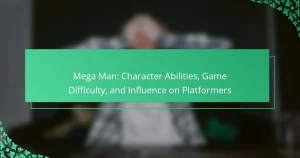Street Fighter II offers a rich competitive experience shaped by its intricate fighting mechanics, character balance, and vibrant community. Players face challenges in mastering timing, spacing, and character strategies. The game’s balance ensures no single character dominates, promoting diverse matchups and innovative tactics. Regional play styles further influence strategies and perceptions, enriching the global competitive landscape.
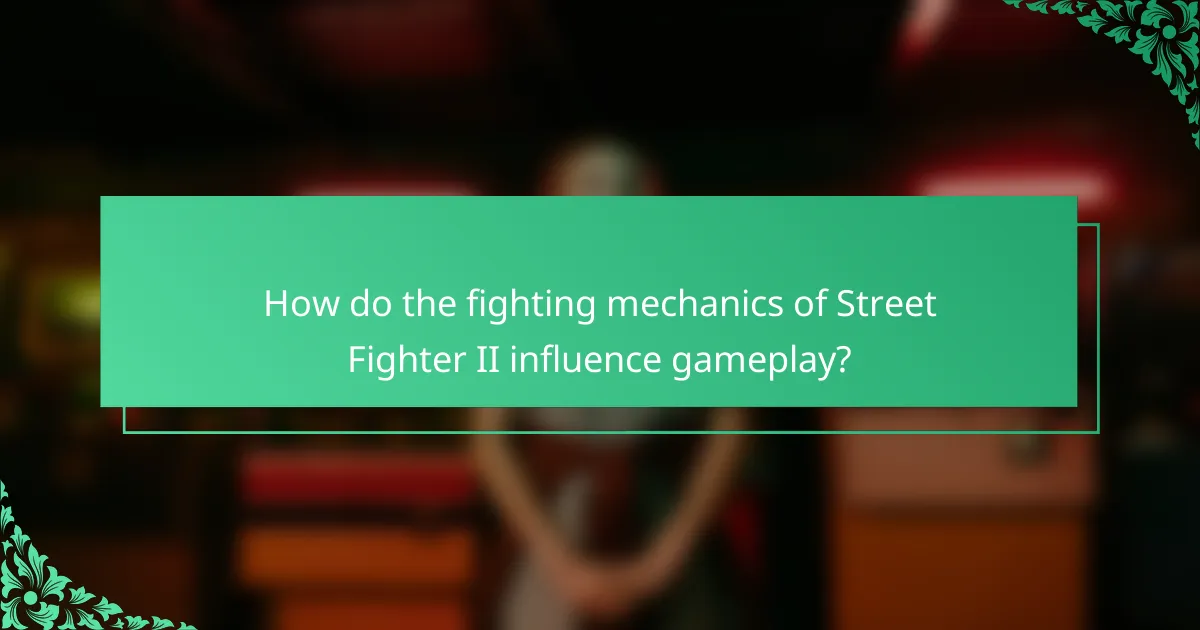
How do the fighting mechanics of Street Fighter II influence gameplay?
The fighting mechanics of Street Fighter II significantly shape gameplay by promoting strategic depth and character balance. Players must master timing, spacing, and combo execution, which create a dynamic competitive environment. The unique attributes of characters, such as special moves and fighting styles, influence matchups and strategies. This balance encourages players to adapt and innovate, enhancing the overall competitive scene. The mechanics also foster a community focused on skill development and mastery, making the game a staple in the fighting game genre.
What are the core gameplay systems and controls in Street Fighter II?
Street Fighter II features core gameplay systems that include character selection, special moves, and combo mechanics. Players engage in one-on-one battles, utilizing unique attributes of each character. The controls are designed for accessibility, allowing for both basic and advanced techniques. Character balance is crucial, as each fighter has strengths and weaknesses that affect competitive play. The competitive scene thrives on player skill, strategy, and understanding of mechanics.
How do special moves and combos enhance player strategy?
Special moves and combos significantly enhance player strategy by adding depth and variety to combat. They allow players to execute complex maneuvers that can turn the tide of a match. Mastery of these techniques offers advantages such as increased damage output and improved control over the pace of the game.
The strategic use of special moves can create openings in an opponent’s defense, leading to opportunities for counterattacks. Players often analyze character balance to determine which moves are most effective in specific matchups. This analysis involves understanding unique attributes of characters, such as their range and speed, which can influence the effectiveness of combos.
In competitive play, the ability to seamlessly integrate special moves into combos can differentiate skilled players from novices. Players who can consistently perform these techniques often achieve higher rankings and success in tournaments. As a result, mastering special moves and combos is essential for anyone looking to excel in the Street Fighter II competitive scene.
What role do frame data and hitboxes play in combat effectiveness?
Frame data and hitboxes significantly influence combat effectiveness in Street Fighter II by determining attack timing and collision interactions. Frame data specifies how many frames an action takes, impacting the speed and safety of moves. Hitboxes define the areas where attacks connect, affecting range and vulnerability. Understanding these elements enables players to optimize their strategies, enhancing competitive performance. Mastery of frame data and hitboxes can lead to improved reaction times and better spacing, crucial for winning matches.
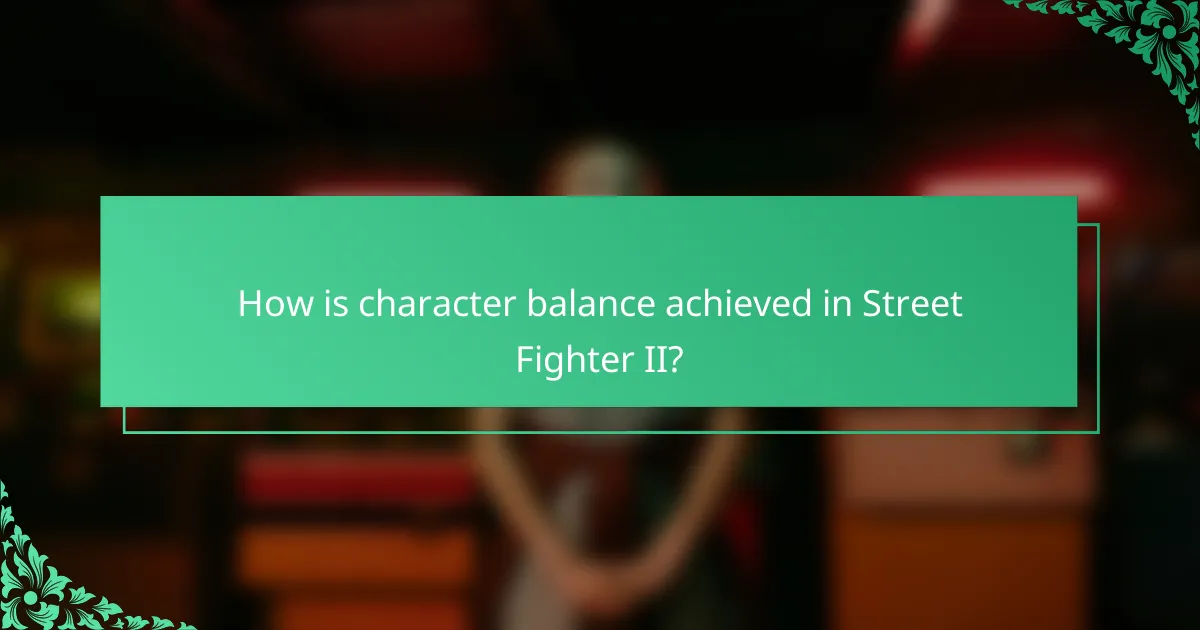
How is character balance achieved in Street Fighter II?
Character balance in Street Fighter II is achieved through careful design of characters’ strengths and weaknesses. Each character has unique abilities, speed, and damage output, creating a diverse competitive landscape. Developers adjusted attributes based on player feedback and tournament results, ensuring no single character dominates. This ongoing refinement fosters a balanced environment for competitive play.
Which factors determine character strength and weaknesses?
Character strength and weaknesses in Street Fighter II are determined by attributes like speed, damage output, and special moves. Each character has unique strengths and weaknesses that impact their effectiveness in competitive play. For instance, some characters excel in mobility, while others have powerful attacks but limited range. Balance is achieved through careful design, ensuring no single character dominates the competitive scene. The interplay of these factors creates a dynamic environment, influencing player strategies and match outcomes.
How do tier lists reflect character viability in competitive play?
Tier lists reflect character viability in competitive play by ranking characters based on their performance and effectiveness. In “Street Fighter II,” character balance is crucial for fair competition. Players analyze matchups, strengths, and weaknesses to determine each character’s standing. A character with high tier status typically has advantageous attributes, such as strong combos or effective zoning techniques. Conversely, lower-tier characters may struggle against popular picks, impacting their viability in tournaments. This evaluation helps players select characters that align with their strategies, enhancing the overall competitive scene.
What adjustments have been made to balance characters over time?
Adjustments to balance characters in Street Fighter II have included numerous patches and updates. Developers have modified character attributes like speed, damage output, and special moves to ensure fair competition. For example, characters previously deemed overpowered received nerfs to their attack strength or recovery times. Additionally, adjustments have been made to enhance weaker characters, granting them improved abilities or combo potential. These changes reflect the competitive scene’s evolution, aiming to create a balanced and engaging gameplay experience.
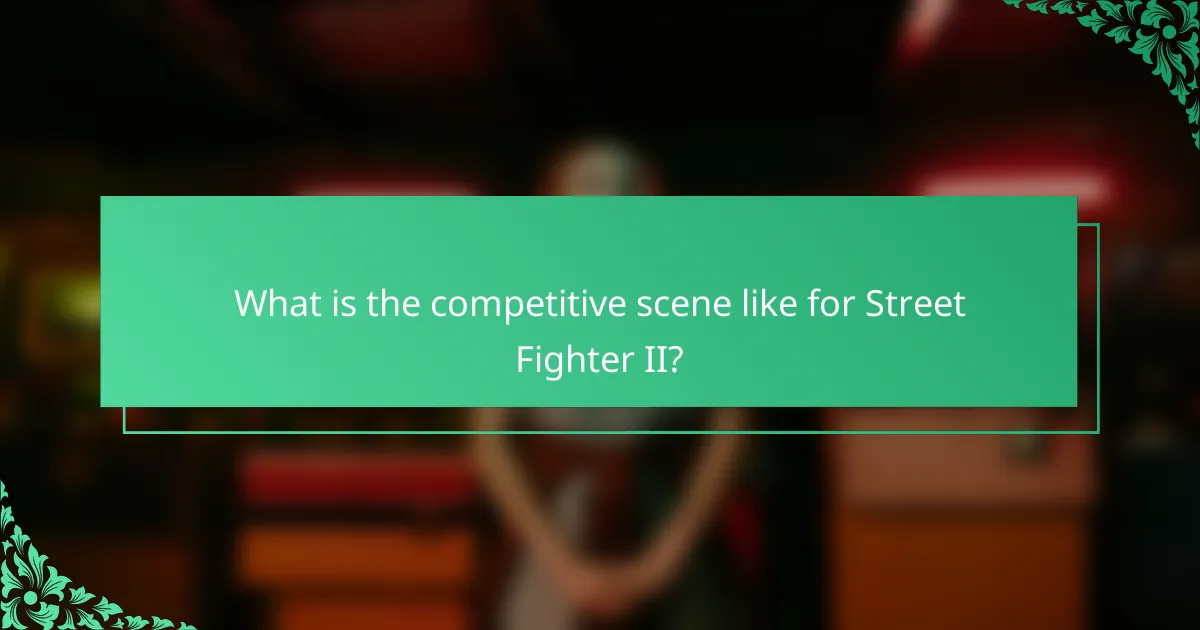
What is the competitive scene like for Street Fighter II?
The competitive scene for Street Fighter II is vibrant and historically significant. Tournaments have been held globally, showcasing player skills and strategies. Character balance plays a crucial role, influencing competitive viability. Players often select top-tier characters to maximize their chances of success. Unique attributes of characters create diverse matchups and strategies. The game’s mechanics, including combos and special moves, also shape the competitive landscape. Street Fighter II remains a cornerstone of fighting game culture, with a dedicated community and ongoing events.
Which tournaments and events are pivotal in the Street Fighter II community?
Major tournaments and events in the Street Fighter II community include EVO, Super Battle Opera, and the Capcom Cup. EVO is renowned for its large participant base and competitive atmosphere, showcasing top players annually. Super Battle Opera, a pivotal event in Japan, emphasizes the game’s roots and features elite competitors. The Capcom Cup highlights the best players globally, further solidifying Street Fighter II’s legacy in competitive gaming. These events contribute to character balance discussions and fighting mechanics evolution.
How do player rankings and leagues operate within the competitive landscape?
Player rankings and leagues in Street Fighter II are structured to foster competitive play and skill evaluation. Rankings are determined by performance in tournaments and online matches, reflecting player skill levels. Leagues organize players into tiers, creating a balanced competitive environment.
The ranking system incentivizes players to improve their skills, as higher ranks often lead to more prestigious tournaments. Character balance is crucial, ensuring no single character dominates the competitive scene. This balance promotes diverse gameplay and strategies, enhancing the overall experience for players and spectators alike.
Tournaments often feature a double-elimination format, allowing players a second chance after an initial loss, which adds depth to the competitive landscape. As a result, the synergy between rankings, leagues, and character balance shapes the evolving meta-game in Street Fighter II.
What role do online platforms play in modern competitive play?
Online platforms are crucial in modern competitive play, enhancing accessibility and community engagement. They facilitate matchmaking, allowing players to find opponents of similar skill levels. These platforms also support streaming and content creation, promoting visibility for players and tournaments. Additionally, they provide resources for strategy sharing and skill development, contributing to a more informed player base. The unique attribute of online platforms is their ability to connect global players, fostering a diverse competitive environment.
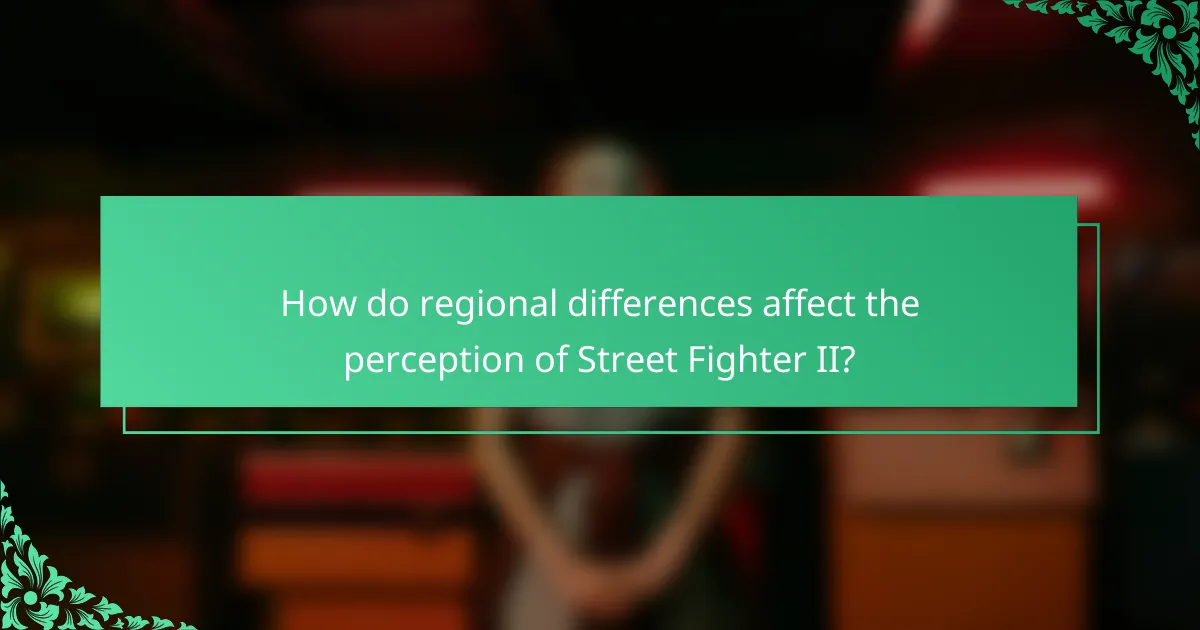
How do regional differences affect the perception of Street Fighter II?
Regional differences significantly influence the perception of Street Fighter II through cultural context and competitive priorities. In Japan, the game is often viewed as a cornerstone of arcade culture, emphasizing technical skill and character mastery. Conversely, in North America, the focus may lean towards casual play and community events, shaping a more relaxed competitive scene.
Character balance perceptions vary regionally as well. Players in competitive environments may prioritize different characters based on local meta, affecting tournament outcomes. For example, in Japan, players might favor characters with strong combo potential, while North American players may select characters based on popularity or ease of use.
Additionally, the game’s fighting mechanics are interpreted through regional play styles. Japanese players often emphasize precision and timing, while North American players may adopt a more aggressive approach. This divergence leads to unique strategies and player preferences that enrich the global competitive landscape.
In summary, cultural factors and local gaming communities shape how Street Fighter II is perceived, influencing everything from character selection to competitive dynamics.
What unique strategies are popular in different regions?
Different regions adopt unique strategies in Street Fighter II based on local playstyles and character preferences. For example, players in Japan often emphasize aggressive tactics and character mastery, while North American players may focus on zoning and defensive play. European players typically balance both approaches, showcasing adaptability. Regional tournaments highlight these strategies, influencing character balance and competitive dynamics.
How do cultural influences shape character choices and play styles?
Cultural influences significantly shape character choices and play styles in Street Fighter II. Players often gravitate toward characters that reflect their cultural backgrounds or resonate with their personal experiences.
For example, characters like Ryu embody traditional martial arts, appealing to players who value discipline and honour. In contrast, characters like Blanka, with their unique fighting styles and backgrounds, attract players seeking novelty and excitement.
Moreover, competitive scenes often reflect regional preferences, where certain characters dominate based on local cultural contexts. This dynamic creates a diverse meta where character balance and play styles evolve, influenced by cultural interpretations of gameplay and strategy.
Ultimately, the interplay between culture and gameplay fosters a rich competitive environment, enhancing player engagement and community interaction.

What are the common challenges faced by players in Street Fighter II?
Players in Street Fighter II commonly face challenges related to character balance, input timing, and competitive pressure. Character balance varies, leading to perceived advantages among fighters. Input timing is crucial, as precise execution affects combos and special moves. Competitive pressure can create stress, impacting performance during matches. These factors collectively shape the gameplay experience and influence player strategies.
Which skills are most important for mastering the game?
Mastering Street Fighter II requires skills in timing, spacing, and character knowledge. Players must understand frame data to execute moves effectively and anticipate opponents’ actions. Mastery of combos enhances damage output while maintaining pressure. Adaptability within the competitive scene is crucial for countering diverse play styles.
What are the common pitfalls for new players?
New players in Street Fighter II often struggle with basic mechanics, character selection, and strategy. Common pitfalls include relying too heavily on one character, neglecting defence, and failing to learn combos. Additionally, many players underestimate the importance of spacing and timing during matches. Understanding character balance is crucial, as each fighter has unique strengths and weaknesses that can impact gameplay.
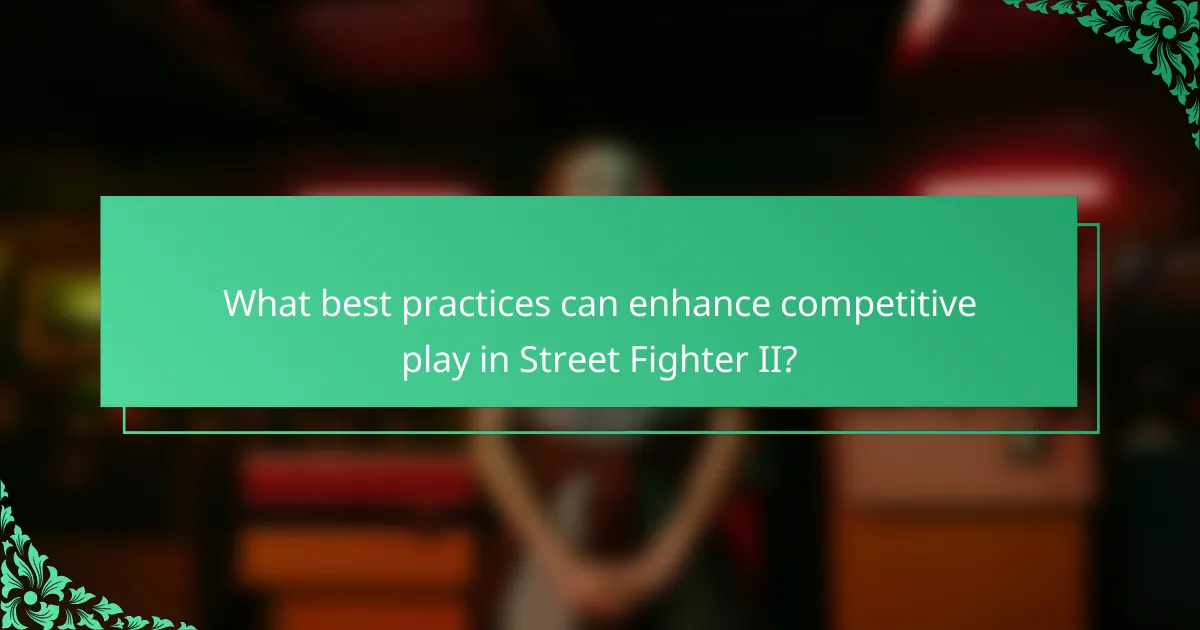
What best practices can enhance competitive play in Street Fighter II?
To enhance competitive play in Street Fighter II, players should focus on mastering character mechanics, optimizing strategies, and understanding matchups. Key practices include practicing combos, maintaining spacing, and utilizing character strengths effectively.
1. Master character mechanics: Learn unique moves and combos for your chosen character.
2. Optimize strategies: Develop a mix of offensive and defensive tactics tailored to your playstyle.
3. Understand matchups: Study how different characters interact to exploit weaknesses.
4. Maintain spacing: Control distance to avoid attacks and set up counter opportunities.
5. Analyze gameplay: Record and review matches to identify areas for improvement.
How can players effectively analyze their gameplay for improvement?
Players can analyze their gameplay by reviewing match recordings and identifying patterns. Focus on understanding character strengths and weaknesses, as well as opponent strategies. Key areas to evaluate include decision-making, combo execution, and spacing. Utilize training modes to practice specific techniques and refine skills. Regularly engaging in self-reflection and seeking feedback from peers enhances improvement.
What strategies can be employed to adapt to various opponents?
To adapt to various opponents in Street Fighter II, players should employ strategies that enhance their understanding of character matchups and mechanics. Analyze opponents’ playstyles and adjust tactics accordingly.
Focus on mastering a few key characters to develop a deep understanding of their strengths and weaknesses. This knowledge enables players to exploit opponents’ vulnerabilities effectively. Utilize spacing and timing to control the pace of the match, making it difficult for opponents to execute their strategies.
Incorporate mind games and baiting techniques to provoke mistakes from opponents. By predicting their moves, players can create openings for counterattacks. Lastly, practice regularly to refine skills and improve reaction times, ensuring readiness against diverse playstyles in competitive scenarios.


